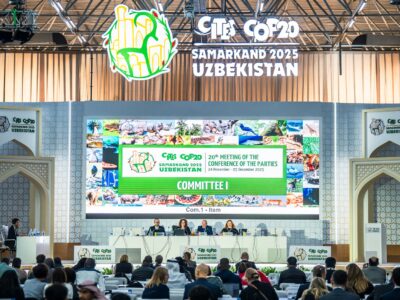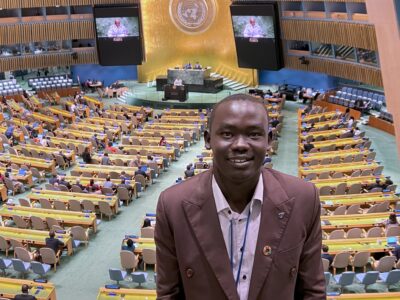
How can educators empower students to help build a better future? Teaching sustainability in schools is one important way, but it can be challenging to identify the most effective approaches to this complex and rapidly evolving field.
To aid in this process, the Columbia Climate School’s Research Program on Sustainability Policy and Management and the Lamont-Doherty Earth Observatory are partnering with the Tencent Foundation to develop a set of sustainable education modules for secondary school students. The modules, all developed in English, will be piloted in a bilingual school in Shenzhen, China. The curriculum could readily be adapted to suit other contexts including the U.S.
The curriculum modules cover seven interrelated topics of sustainability, ranging from the science of climate change and oceans sustainability to renewable energy and sustainable cities. These modules are designed to help students understand sustainability as a system encompassing many interrelated environmental, economic and social issues; and to appreciate the intricacies of sustainability policies, particularly when many stakeholders with varying and conflicting interests are involved. Each module consists of basic content overview, case studies, project-based learning and student activities, as well as resources and lesson plans for teachers.
Last summer, the research team welcomed two public school teachers, Erika Stafne and Stephanie Alston, to the project as part of the National Science Foundation Research Experiences for Teachers (RET) program. Stafne and Alston are helping with the two final curricula on sustainable cities and renewable energy for grades 11 and 12.
Erika Stafne has been in public school education for 22 years and currently teaches environmental science and Earth science at Independence High School in New York City. Stafne worked on a sustainable-cities module, creating case studies and activities on topics like transportation and food systems. Students assessed their personal and family choices, measured their community’s sustainability and created their own design for a sustainable city.
Stephanie Alston is a teacher at the Charles Flowers High School in Baltimore, Maryland. She currently teaches environmental science, Earth and space and biogeochemical systems. During the RET program, Alston worked on a renewable-energies curriculum module, developing detailed lesson plans and resources using web-based and app-based learning tools, as well as hands-on experiments.
These teachers shared their thoughts on the RET experience and some of the key issues in sustainability education in the Q&A below.
In what ways has the RET program helped your professional development in sustainability education?
Stafne: Classroom teachers often work in isolation, and so the RET program was an incredible opportunity to work alongside experts in climate and sustainability research and education. Being able to hear scientists share their current research and its application, ask questions and then apply that new learning to classroom curriculum was invaluable.
What do you think are the biggest challenges of teaching sustainability?
Alston: The greatest challenge is resistance to change and adapting the education system to incorporate sustainability education. Other challenges are not seeing the relevance of environmental science, lack of agenda in curriculum development, lack of access to appropriate resources and lack of skills in innovative methods, and also that teaching staff may not be able to provide the support necessary for appropriate collaboration.
Stafne: Students often struggle with seeing the need for sustainability because they do not feel the negative impacts of unsustainable choices. Choices like eating locally grown organic food or avoiding fast fashion typically cost more, which also makes sustainability inaccessible to students with lower socioeconomic status. The curriculum we created allows students to connect to global issues on a personal level.
What’s the biggest difference between teaching sustainability and other subjects?
Stafne: Most other subjects place students in the role of observer. Sustainability pushes students to respond based on their own observations, shaping them into engineers, problem-solvers and change agents. Sustainability offers students the chance to be active learners rather than passive participants.
Alston: This type of education requires more place-based and project-based approaches. Teaching sustainability also reminds us that pedagogy is a civic project based on the guidelines of the classroom and community. Therefore, classroom communications and student projects should be relevant to the local community and projects should be designed to allow students to bring changes to their communities.
How do you address the interdisciplinary nature of sustainability education?
Stafne: The interdisciplinary nature of sustainability is one of the most powerful parts of the subject. Some science courses feel exclusionary to students because they are math-heavy or students already believe they are “not good at science.” The key is to incorporate a variety of activities, subjects and experiences in the course of study, so that any student can find an entry point into the content, and every student can connect the learning to their personal lives.
Alston: This is where project-based and place-based active learning is most important and effective. During project-based learning, when students are solving a particular problem, they can actively link and apply the knowledge from multiple disciplines.
What areas of professional development are most necessary for sustainability education teachers?
Alston: Society’s transition to sustainability requires the active participation of all citizens, and education plays a key role in facilitating this, particularly among younger generations. Professional development is the cornerstone of ensuring adequate teaching resources, effective pedagogies and curriculum content to achieve equitable sustainability education.
Stafne: Teachers need access to scientists and professionals in sustainability, as well as opportunities to share their learning and collaborate with other educators. Ongoing professional development with space for learning, creation, implementation, reflection and revision of curriculum would be most impactful.
When it comes to teaching sustainability effectively, educators and school administrators require opportunities, platforms and networks to share and exchange ideas, best practices and resources. Sustainability education is an indispensable component of enabling the current and future generations to promote the wellbeing of society as well as our common ecosystem. Its success will be built on the joint efforts of many people—policymakers, school leaders, educators, parents, students, industries and research institutes like the Columbia Climate School—and will benefit every species on the planet.
Anyi Wang is an associate research scholar at the Earth Institute’s Research Program on Sustainability Policy and Management.
Erika Stafne is New York City public school science teacher at Independence High School, a NASA CCRI Education Ambassador, and a Math for America Master Teacher Fellow.
Stephanie Alston is a teacher at the Charles Flowers High School in Baltimore Maryland, who teaches environmental science, Earth and space and biogeochemical systems for grades 9 through 12.



